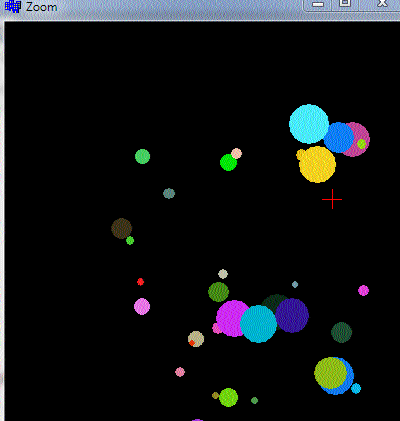Zooming graphics based on current mouse position
I'm trying to zoom a drawing based on the current position of the mouse. Right now my onMouseWheel method looks like this (based on this StackOverflow answer):
private void onMouseWheel(object sender, MouseEventArgs e)
{
if (e.Delta > 0)
{
_scale *= 1.25f;
_translateY = e.Y - 1.25f * (e.Y - _translateY);
_translateX = e.X - 1.25f * (e.X - _translateX);
}
else
{
_scale /= 1.25f;
_translateY = e.Y - 0.8f * (e.Y - _translateY);
_translateX = e.X - 0.8f * (e.X - _translateX);
}
this.Invalidate();
}_scale, _translateX, and _translateY are member variables.
I'm scaling the graphics, translating it, and then drawing the lines like this:
protected override void OnPaint(PaintEventArgs e)
{
g.ScaleTransform(_scale, _scale);
g.TranslateTransform(_translateX, _translateY);
//draw lines here
}This video shows what happens when I try to zoom in and the zoom out on a certain point. What am I doing wrong?
This is what the code looks like in a sample panel class for testing purposes:
class Display : Panel
{
public Display()
{
this.MouseWheel += new MouseEventHandler(this.onMouseWheel);
}
private void onMouseWheel(object sender, MouseEventArgs e)
{
if (e.Delta > 0)
{
_scale *= 1.25f;
_translateY = e.Y - 1.25f * (e.Y - _translateY);
_translateX = e.X - 1.25f * (e.X - _translateX);
}
else
{
_scale /= 1.25f;
_translateY = e.Y - 0.8f * (e.Y - _translateY);
_translateX = e.X - 0.8f * (e.X - _translateX);
}
this.Invalidate();
}
protected override void OnPaint(PaintEventArgs e)
{
g.ScaleTransform(_scale, _scale);
g.TranslateTransform(_translateX, _translateY);
Pen pen = new Pen(Color.Red);
g.FillEllipse(pen.Brush, 50, 50, 10, 10);
}
}Solution 1:
Too lazy to make the equations right (and most likely would made similar mistake as you... I do not know if it is just me but exactly this easy stuff I cant handle and drives me mad). Instead I am dealing with this kind of tasks as follows (it is much safer from mistakes):
-
create transform functions between screen and world coordinates
So your mouse position is in screen coordinates and rendered stuff is in world coordinates. As this is only 2D then it is easy. make function that converts between these two. Your world to screen transform (if I am not overlooking something) is this:
g.ScaleTransform(_scale, _scale); g.TranslateTransform(_translateX, _translateY);so:
screen_x=(world_x*_scale)+_translateX; screen_y=(world_y*_scale)+_translateY;So the reverse:
world_x=(screen_x-_translateX)/_scale; world_y=(screen_y-_translateY)/_scale; -
change of zoom/scale
The idea is that after zoom/scale change the mouse position should stay the same in world coordinates as before. so remember world coordinates of mouse before change. Then compute from it the screen position after change and the difference put into translation.
Here simple C++ example:
double x0=0.0,y0=0.0,zoom=1.0,mx,my;
//---------------------------------------------------------------------------
void scr2obj(double &ox,double &oy,double sx,double sy)
{
ox=(sx-x0)/zoom;
oy=(sy-y0)/zoom;
}
//---------------------------------------------------------------------------
void obj2scr(double &sx,double &sy,double ox,double oy)
{
sx=x0+(ox*zoom);
sy=y0+(oy*zoom);
}
//---------------------------------------------------------------------------
void __fastcall TForm1::FormMouseWheelDown(TObject *Sender, TShiftState Shift,TPoint &MousePos, bool &Handled)
{
double mx0,my0;
scr2obj(mx0,my0,mx,my);
zoom/=1.25; // zoom out
obj2scr(mx0,my0,mx0,my0);
x0+=mx-mx0;
y0+=my-my0;
_redraw=true;
}
//---------------------------------------------------------------------------
void __fastcall TForm1::FormMouseWheelUp(TObject *Sender, TShiftState Shift, TPoint &MousePos, bool &Handled)
{
double mx0,my0;
scr2obj(mx0,my0,mx,my);
zoom*=1.25; // zoom in
obj2scr(mx0,my0,mx0,my0);
x0+=mx-mx0;
y0+=my-my0;
_redraw=true;
}
//---------------------------------------------------------------------------
void __fastcall TForm1::FormMouseMove(TObject *Sender, TShiftState Shift, int X,int Y)
{
mx=X; my=Y;
}
//---------------------------------------------------------------------------the mx,my is actual mouse position in screen coordinates, the x0,y0 is the translation and zoom is the scale.
And here captured GIF animation of this:

[edit1] It looks like your gfx objects use transponed matrices
That means the order of transformations is reversed so the equations change a bit... Here your case example in C++:
void scr2obj(double &ox,double &oy,double sx,double sy)
{
// ox=(sx-x0)/zoom;
// oy=(sy-y0)/zoom;
ox=(sx/zoom)-x0;
oy=(sy/zoom)-y0;
}
//---------------------------------------------------------------------------
void obj2scr(double &sx,double &sy,double ox,double oy)
{
// sx=x0+(ox*zoom);
// sy=y0+(oy*zoom);
sx=(x0+ox)*zoom;
sy=(y0+oy)*zoom;
}
//---------------------------------------------------------------------------
void __fastcall TForm1::FormMouseWheelDown(TObject *Sender, TShiftState Shift,TPoint &MousePos, bool &Handled)
{
double mx0,my0;
scr2obj(mx0,my0,mx,my);
zoom/=1.25; // zoom out
obj2scr(mx0,my0,mx0,my0);
// x0+=mx-mx0;
// y0+=my-my0;
x0+=(mx-mx0)/zoom;
y0+=(my-my0)/zoom;
_redraw=true;
}
//---------------------------------------------------------------------------
void __fastcall TForm1::FormMouseWheelUp(TObject *Sender, TShiftState Shift, TPoint &MousePos, bool &Handled)
{
double mx0,my0;
scr2obj(mx0,my0,mx,my);
zoom*=1.25; // zoom in
obj2scr(mx0,my0,mx0,my0);
// x0+=mx-mx0;
// y0+=my-my0;
x0+=(mx-mx0)/zoom;
y0+=(my-my0)/zoom;
_redraw=true;
}
//---------------------------------------------------------------------------